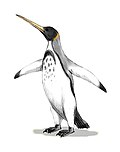Muriwaimanu
| Muriwaimanu Temporal range: Paleocene,
~ | |
|---|---|

| |
| Partial specimen of cf. Muriwaimanu tuatahi | |
| Scientific classification | |
| Domain: | Eukaryota |
| Kingdom: | Animalia |
| Phylum: | Chordata |
| Class: | Aves |
| Order: | Sphenisciformes |
| Genus: | †Muriwaimanu Mayr et al., 2018 |
| Species: | †M. tuatahi
|
| Binomial name | |
| †Muriwaimanu tuatahi Mayr et al., 2018
| |
| Synonyms | |
| |
Muriwaimanu is an extinct genus of early penguin from the Paleocene Waipara Greensand of New Zealand. Only the type species M. tuatahi is known.[1]
Etymology
[edit]The name Muriwaimanu comes from muri, Māori for "after", and Waimanu, referring to the fact that the fossils come from younger strata than Waimanu.[1]
Discovery and naming
[edit]The holotype was discovered in 1980 within the Waipara Greensand near the Waipara River, in Canterbury, New Zealand, and it was initially named Waimanu tuatahi by Slack et al. (2006).[2] Mayr et al. (2018) re-examined the specimen and determined that it belonged to a separate genus, creating the species Muriwaimanu tuatahi.[1]
A second specimen from the Waipara Greensand (CM 2018.124.4), identified as belonging to cf. Muriwaimanu tuatahi and consisting of a partial specimen preserved within two blocks of sandstone, was discovered by Leigh Love in 2017 and was described by Mayr et al. (2020).[3]
Description
[edit]Muriwaimanu exhibited a long, narrow beak and paddle-shaped wings, and the fossilized remains also indicate it may have kept their wings in a flexed position during downward strokes, unlike modern penguins whose wings are kept extended, suggesting that Muriwaimanu may be a transition species for modern Antarctic penguins.[3]
See also
[edit]References
[edit]- ^ a b c Gerald Mayr; Vanesa L. De Pietri; Leigh Love; Al A. Mannering; R. Paul Scofield (2018). "A well-preserved new mid-Paleocene penguin (Aves, Sphenisciformes) from the Waipara Greensand in New Zealand". Journal of Vertebrate Paleontology. 37 (6): e1398169. doi:10.1080/02724634.2017.1398169. S2CID 89744522.
- ^ Slack, K.E., Jones, C.M., Ando, T., Harrison G.L., Fordyce R.E., Arnason, U. and Penny, D. (2006). "Early Penguin Fossils, plus Mitochondrial Genomes, Calibrate Avian Evolution." Molecular Biology and Evolution, 23(6): 1144-1155. doi:10.1093/molbev/msj124 PDF fulltext Supplementary Material Archived 2009-12-16 at the Wayback Machine
- ^ a b Mayr, Gerald; De Pietri, Vanesa L.; Love, Leigh; Mannering, Al A.; Bevitt, Joseph J.; Scofield, R. Paul (2020-01-26). "First Complete Wing of a Stem Group Sphenisciform from the Paleocene of New Zealand Sheds Light on the Evolution of the Penguin Flipper". Diversity. 12 (2): 46. doi:10.3390/d12020046. ISSN 1424-2818.


